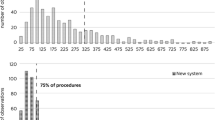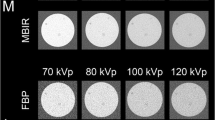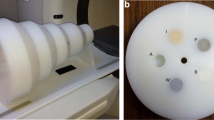Abstract
Objectives
The objective of this study was to assess the influence of an iterative CT reconstruction algorithm (IA), newly available for CT-fluoroscopy (CTF), on image noise, readers’ confidence and effective dose compared to filtered back projection (FBP).
Methods
Data from 165 patients (FBP/IA = 82/74) with CTF in the thorax, abdomen and pelvis were included. Noise was analysed in a large-diameter vessel. The impact of reconstruction and variables (e.g. X-ray tube current I) influencing noise and effective dose were analysed by ANOVA and a pairwise t-test with Bonferroni–Holm correction. Noise and readers’ confidence were evaluated by three readers.
Results
Noise was significantly influenced by reconstruction, I, body region and circumference (all p ≤ 0.0002). IA reduced the noise significantly compared to FBP (p = 0.02). The effect varied for body regions and circumferences (p ≤ 0.001). The effective dose was influenced by the reconstruction, body region, interventional procedure and I (all p ≤ 0.02). The inter-rater reliability for noise and readers’ confidence was good (W ≥ 0.75, p < 0.0001). Noise and readers’ confidence were significantly better in AIDR-3D compared to FBP (p ≤ 0.03). Generally, IA yielded a significant reduction of the median effective dose.
Conclusion
The CTF reconstruction by IA showed a significant reduction in noise and effective dose while readers’ confidence increased.
Key Points
• CTF is performed for image guidance in interventional radiology.
• Patient exposure was estimated from DLP documented by the CT.
• Iterative CT reconstruction is appropriate to reduce image noise in CTF.
• Using iterative CT reconstruction, the effective dose was significantly reduced in abdominal interventions.




Similar content being viewed by others
Abbreviations
- AIDR 3D:
-
Adaptive Iterative Dose Reduction 3D
- ANOVA:
-
Analysis of variance
- BMI:
-
Body mass index
- CTF:
-
CT fluoroscopy
- DLP:
-
Dose length product
- FBP:
-
Filtered back projection
- HU:
-
Hounsfield units
- I:
-
X-ray tube current
- IQR:
-
Interquartile range
- IR:
-
Interventional radiologist
- MWA:
-
Microwave ablation
- PMMA:
-
Polymethylmethacrylate
- RFA:
-
Radiofrequency ablation
- ROI:
-
Region of interest
References
Froelich JJ, Ishaque N, Regn J, Saar B, Walthers EM, Klose KJ (2002) Guidance of percutaneous pulmonary biopsies with real-time CT fluoroscopy. Eur J Radiol 42:74–79
Silverman SG, Tuncali K, Adams DF, Hooton S, Tuncali K, Adams DF (1999) CT fluoroscopy-guided abdominal interventions: techniques, results, and radiation exposure. Radiology 212:673–681
Kim GR, Hur J, Lee SM et al (2011) CT fluoroscopy-guided lung biopsy versus conventional CT-guided lung biopsy: a prospective controlled study to assess radiation doses and diagnostic performance. Eur Radiol 21:232–239
Carlson SK, Bender CE, Classic KL et al (2001) Benefits and safety of CT fluoroscopy in interventional radiologic procedures. Radiology 219:515–520
Prosch H, Stadler A, Schilling M et al (2012) CT fluoroscopy-guided vs. multislice CT biopsy mode-guided lung biopsies: accuracy, complications and radiation dose. Eur J Radiol 81:1029–1033
Kloeckner R, dos Santos DP, Schneider J, Kara L, Dueber C, Pitton MB (2013) Radiation exposure in CT-guided interventions. Eur J Radiol 82:2253–2257
Pereira MF, Alves JG, Sarmento S et al (2011) Preliminary assessment of the dose to the interventional radiologist in fluoro-CT-guided procedures. Radiat Prot Dosim 144:448–452
Nawfel RD, Judy PF, Silverman SG et al (2000) Patient and personnel exposure during CT fluoroscopy-guided interventional procedures. Radiology 216:180–184
Tsalafoutas IA, Tsapaki V, Triantopoulou C, Gorantonaki A, Papailiou J (2007) CT-guided interventional procedures without CT fluoroscopy assistance: patient effective dose and absorbed dose considerations. Am J Roentgenol 188:1479–1484
Joemai RMS, Zweers D, Obermann WR, Geleijns J (2009) Assessment of patient and occupational dose in established and new applications of MDCT fluoroscopy. Am J Roentgenol 192:881–886
Wagner LK, Eifel PJ, Geise RA (1994) Potential biological effects following high X-ray dose interventional procedures. J Vasc Interv Radiol 5:71–84
Berrington de González A, Darby S (2004) Risk of cancer from diagnostic X-rays: estimates for the UK and 14 other countries. Lancet 363:345–351
National Council on Radiation Protection (2009) Ionizing radiation exposure of the population of the United States. National Council on Radiation Protection and Measurements, Bethesda, MD
Grosser OS, Kupitz D, Ruf J et al (2015) Optimization of SPECT-CT Hybrid Imaging Using Iterative Image Reconstruction for Low-Dose CT: A Phantom Study. PLoS ONE 10, e0138658
Xia T, Alessio AM, De Man B, Manjeshwar R, Asma E, Kinahan PE (2012) Ultra-low dose CT attenuation correction for PET/CT. Phys Med Biol 57:309–328
Martinsen ACT, Sæther HK, Hol PK, Olsen DR, Skaane P (2012) Iterative reconstruction reduces abdominal CT dose. Eur J Radiol 81:1483–1487
Sagara Y, Hara AK, Pavlicek W, Silva AC, Paden RG, Wu Q (2010) Abdominal CT: comparison of low-dose CT with adaptive statistical iterative reconstruction and routine-dose CT with filtered back projection in 53 patients. Am J Roentgenol 195:713–719
Hara AK, Paden RG, Silva AC, Kujak JL, Lawder HJ, Pavlicek W (2009) Iterative reconstruction technique for reducing body radiation dose at CT: feasibility study. Am J Roentgenol 193:764–771
Leipsic J, Labounty TM, Heilbron B et al (2010) Estimated radiation dose reduction using adaptive statistical iterative reconstruction in coronary CT angiography: the ERASIR study. Am J Roentgenol 195:655–660
Gebhard C, Fuchs TA, Fiechter M et al (2013) Image quality of low-dose CCTA in obese patients: impact of high-definition computed tomography and adaptive statistical iterative reconstruction. Int J Cardiovasc Imaging 29:1565–1574
Singh S, Kalra MK, Do S et al (2012) Comparison of hybrid and pure iterative reconstruction techniques with conventional filtered back projection: dose reduction potential in the abdomen. J Comput Assist Tomogr 36:347–353
Hérin E, Gardavaud F, Chiaradia M et al (2015) Use of Model-Based Iterative Reconstruction (MBIR) in reduced-dose CT for routine follow-up of patients with malignant lymphoma: dose savings, image quality and phantom study. Eur Radiol 25:2362–2370
International Commission on Radiation Units and Measurements (2012) ICRU Report No. 87: Radiation dose and image-quality assessment in computed tomography. J ICRU 12:1–149
Hsieh J (2009) Computed Tomography: principles, design, artifacts, and recent advances, 2nd edn. SPIE, Bellingham
Schneider CA, Rasband WS, Eliceiri KW (2012) NIH Image to ImageJ: 25 years of image analysis. Nat Methods 9:671–675
Rosset A, Spadola L, Ratib O (2004) OsiriX: an open-source software for navigating in multidimensional DICOM images. J Digit Imaging 17:205–216
International Electrotechnical Commission (2009), Medical electrical equipment - Part 2-44: Particular requirements for the basic safety and essential performance of X-ray equipment for computed tomography, IEC publication No. 60601-2-44
ICRP (2007) The 2007 Recommendations of the International Commission on Radiological Protection. ICRP publication 103. Ann ICRP 37
Bongartz G, Golding SJ, Jurik AG, et al. (2004) European Guidelines for Multislice Computed Tomography. European Commission, EUR 16262 EN
Shrimpton PC, Hillier MC, Lewis MA, Dunn M (2006) National survey of doses from CT in the UK: 2003. Br J Radiol 79:968–980
Menke J (2005) Comparison of different body size parameters for individual dose adaptation in body CT of adults. Radiology 236:565–571
Mitsumori LM, Shuman WP, Busey JM, Kolokythas O, Koprowicz KM (2012) Adaptive statistical iterative reconstruction versus filtered back projection in the same patient: 64 channel liver CT image quality and patient radiation dose. Eur Radiol 22:138–143
Fleischmann D, Boas FE (2011) Computed tomography - old ideas and new technology. Eur Radiol 21:510–517
Neeman Z, Dromi SA, Sarin S, Wood BJ (2006) CT fluoroscopy shielding: decreases in scattered radiation for the patient and operator. J Vasc Interv Radiol 17:1999–2004
Kato R, Katada K, Anno H, Suzuki S, Ida Y, Koga S (1996) Radiation dosimetry at CT fluoroscopy: physician's hand dose and development of needle holders. Radiology 201:576–578
Irie T, Kajitani M, Itai Y (2001) CT fluoroscopy-guided intervention: marked reduction of scattered radiation dose to the physician's hand by use of a lead plate and an improved I-I device. J Vasc Interv Radiol 12:1417–1421
Katada K, Kato R, Anno H et al (1996) Guidance with real-time CT fluoroscopy: early clinical experience. Radiology 200:851–856
Stoeckelhuber BM, Leibecke T, Schulz E et al (2005) Radiation dose to the radiologist's hand during continuous CT fluoroscopy-guided interventions. Cardiovasc Intervent Radiol 28:589–594
Mahnken AH, Sedlmair M, Ritter C, Banckwitz R, Flohr T (2012) Efficacy of lower-body shielding in computed tomography fluoroscopy-guided interventions. Cardiovasc Intervent Radiol 35:1475–1479
Hohl C, Suess C, Wildberger JE et al (2008) Dose reduction during CT fluoroscopy: phantom study of angular beam modulation. Radiology 246:519–525
Acknowledgements
We thank Toshiba Medical Systems Corporation for funding the clinical trial.
Author information
Authors and Affiliations
Corresponding author
Ethics declarations
Guarantor
The scientific guarantor of this publication is Jens Ricke.
Conflict of interest
The authors of this manuscript declare relationships with Toshiba Medical Systems Corporation.
Funding
This study has received funding by Toshiba Medical Systems Corporation.
Statistics and biometry
One of the authors has significant statistical expertise.
Ethical approval
Institutional Review Board approval was obtained.
Informed consent
Written informed consent was obtained from all subjects (patients) in this study.
Methodology
• retrospective
• observational
• performed at one institution
Electronic supplementary material
Below is the link to the electronic supplementary material.
ESM 1
(DOC 73 kb)
Rights and permissions
About this article
Cite this article
Grosser, O.S., Wybranski, C., Kupitz, D. et al. Improvement of image quality and dose management in CT fluoroscopy by iterative 3D image reconstruction. Eur Radiol 27, 3625–3634 (2017). https://doi.org/10.1007/s00330-017-4754-7
Received:
Revised:
Accepted:
Published:
Issue Date:
DOI: https://doi.org/10.1007/s00330-017-4754-7




